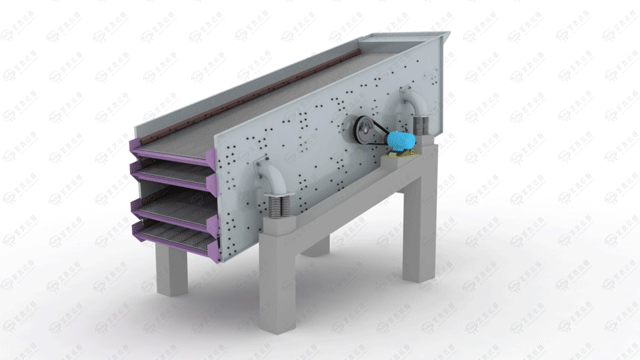A sand and gravel vibrating screen is a specialized piece of equipment designed to efficiently separate granular materials such as sand, gravel, and crushed stone into multiple grades by particle size. These screens are typically used in various industries including construction, mining, aggregate processing, and recycling. Their primary function is to classify materials based on their size, ensuring that each fraction is properly sorted for its intended use.

Components and Construction: A typical sand and gravel vibrating screen consists of several key components:
- Screen Surface: The screen surface is the main working area where the material separation occurs. It is usually made of durable materials such as woven wire mesh, polyurethane, rubber, or perforated steel plates. The choice of screen surface material depends on factors such as the type of material being processed, desired screening efficiency, and wear resistance.
- Screen Frame: The screen surface is supported by a rigid frame structure, which provides stability and ensures proper tensioning of the screen panels. The frame is often constructed from steel or other sturdy materials to withstand the rigors of continuous operation.
- Vibrating Mechanism: The vibrating mechanism is responsible for imparting vibratory motion to the screen surface, which helps to efficiently convey and separate the material. It typically consists of one or more vibratory motors mounted eccentrically on the screen frame. The rotation of these motors generates high-frequency vibrations, causing the screen surface to oscillate.
- Deck Configuration: Sand and gravel vibrating screens may feature multiple decks or levels of screening surfaces stacked on top of each other. Each deck may have different-sized openings or meshes to achieve the desired particle size distribution. The material passes through each deck sequentially, with finer particles falling through the openings while larger particles are retained on the screen surface.
Operation: During operation, the sand and gravel mixture is fed onto the vibrating screen from a hopper or conveyor belt. As the material moves along the screen surface, the vibratory motion generated by the vibrating mechanism causes it to stratify according to particle size. Smaller particles pass through the openings in the screen surface and are collected as undersize material, while larger particles are retained and discharged from the end of the screen.
The amplitude and frequency of the vibrations can be adjusted to optimize the screening process for different types of materials and desired particle size distributions. Additionally, the angle of inclination of the screen surface can be modified to enhance the material flow and screening efficiency.
Benefits:
- Efficient Material Separation: Sand and gravel vibrating screens are highly effective at separating materials of varying sizes, ensuring that each fraction meets the specified requirements.
- High Capacity: These screens can handle large volumes of material, making them suitable for high-capacity screening operations.
- Versatility: They can be used to screen a wide range of materials, including sand, gravel, aggregates, crushed stone, and recycled materials.
- Low Maintenance: With proper maintenance, sand and gravel vibrating screens can offer reliable performance and longevity.
In summary, a sand and gravel vibrating screen is a versatile and efficient piece of equipment used in various industries for the classification and separation of granular materials based on particle size. Its robust construction, adjustable parameters, and high screening capacity make it indispensable in many material processing applications.
